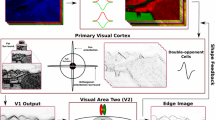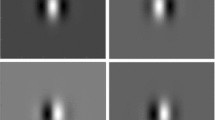Abstract
Contrast stimuli are the essential components that constitute visual scenes. This paper studies how retinal ganglion cells respond to a contrast stimulus covering their concentric receptive fields with center-surround antagonism, and thereby proposes a mathematical model that describes the response by the multiplication of the contrast of the stimulus and a normalized response function with respect to the coverage ratio and the center/surround ratio. The obtained response curves turn out to be consistent with physiological data. This model partially accounts for the contrast sensitivities of ganglion cells and the invariance of visual perception to the contrast. A computational approach based on this neural model is developed for orientation detection, and is further applied to image representation. The experiments achieve convincing results on challenging image datasets. Moreover, it is revealed that the produced orientation maps remarkably enhance the efficiencies and the effectiveness of segmentation algorithms.
Similar content being viewed by others
References
Arbeláez P, Maire M, Fowlkes C, Malik J (2011) Contour detection and hierarchical image segmentation. IEEE Trans Pattern Anal Mach Intell 33(5): 898–916
Arbib MA (ed) (2002) Sensory systems. In: The handbook of brain theory and neural networks, 2nd edn., chap. 2.7. The MIT Press, Cambridge 66–67
Borji A, Hamidi M, Mahmoudi F (2008) Robust handwritten character recognition with features inspired by visual ventral stream. Neural Process Lett 28: 97–111
Chen AH, Zhou Y, Gong HQ, Liang PJ (2005) Luminance adaptation increased the contrast sensitivity of retinal ganglion cells. NeuroReport 16(4): 371–375
Chirimuuta M, Gold I (2009) The embedded neuron, the enactive field?. In: Bickle J (ed) The Oxford handbook of philosophy and neuroscience, chap. 9. Oxford University Press, Oxford, p 200
Croner LJ, Kaplan E (1995) Receptive fields of P and M ganglion cells across the primate retina. Vis Res 35(1): 7–24
Dhingra NK, Freed MA, Smith RG (2005) Voltage-gated sodium channels improve contrast sensitivity of a retinal ganglion cell. J Neurosci 25(35): 8097–8103
Diedrich E, Schaeffel F (2009) Spatial resolution, contrast sensitivity, and sensitivity to defocus of chicken retinal ganglion cells in vitro. Vis Neurosci 26(5–6): 467–476
Einevoll G (2003) Mathematical modelling in the early visual system: why and how. In: Buracas G, Ruksenas O, Albright T, Boynton G (eds) NATO advanced institute series: modulation of neuronal signaling: implications for visual perception, vol 334. IOS Press, Amsterdam (2003)
Einevoll GT, Plesser HE (2005) Response of the difference-of-Gaussians model to circular drifting-grating patches. Vis Neurosci 22(04): 437–446
Enroth-Cugell C, Freeman AW (1987) The receptive-field spatial structure of cat retinal y cells. J Physiol 384(1): 49–79
Enroth-Cugell C, Robson JG (1966) The contrast sensitivity of retinal ganglion cells of the cat. J Physiol Lond 187(3): 517–552
Fairchild MD (2005) Receptive fields. In: Color appearance models, 2nd edn., chap. 1. Wiley, p 15
Heeger DJ (1992) Normalization of cell responses in cat striate cortex. Vis Neurosci 9(2): 181–197
Jerez J, Atencia M, Vico F (2005) A learning rule to model the development of orientation selectivity in visual cortex. Neural Process Lett 21: 1–20
Kilavik BE, Silveira LCL, Kremers J (2003) Centre and surround responses of marmoset lateral geniculate neurones at different temporal frequencies. J Physiol 546(3): 903–919
Kolb H, Nelson R, Fernandez E, Jones BW (2011) Ganglion cell physiology. http://webvision.med.utah.edu/book/part-ii-anatomy-and-physiology-of-the-retina/ganglion-cell-physiology
Lee BB, Sun H (2011) Contrast sensitivity and retinal ganglion cell responses in the primate. Psychol Neurosci 4: 11–18
Maire M, Arbeláez P, Fowlkes C, Malik J (2008) Using contours to detect and localize junctions in natural images. In: IEEE conference on computer vision and pattern recognition, pp 1–8
Malmivuo J, Plonsey R (1995) Bioelectric function of the nerve cell. In: Bioelectromagnetism: principles and applications of bioelectric and biomagnetic fields, 1st edn., chap. 2.5. Oxford University Press
Medina-Carnicer R, Munoz-Salinas R, Yeguas-Bolivar E, Diaz-Mas L (2011) A novel method to look for the hysteresis thresholds for the Canny edge detector. Pattern Recognit 44(6): 1201–1211
Meftah B, Lezoray O, Benyettou A (2010) Segmentation and edge detection based on spiking neural network model. Neural Process Lett 32: 131–146
Papari G, Petkov N (2011) Edge and line oriented contour detection: State of the art. Image Vis Comput 29(2C3): 79–103
Pitkow X, Meister M (2012) Decorrelation and efficient coding by retinal ganglion cells. Nat Neurosci 15(4): 628–635
Risner ML, Amthor FR, Gawne TJ (2010) The response dynamics of rabbit retinal ganglion cells to simulated blur. Vis Neurosci 27(1–2): 43–55
Rodieck RW (1965) Quantitative analysis of cat retinal ganglion cell response to visual stimuli. Vis Res 5(12): 583–601
Russ JC (2011) The image processing handbook, 6th edn., chap. 6. CRC Press, p 376
Russell TL, Werblin FS (2010) Retinal synaptic pathways underlying the response of the rabbit local edge detctor. J Neurophysiol 103(5): 2757–2769
Sadagopan S, Ferster D (2012) Feedforward origins of response variability underlying contrast invariant orientation tuning in cat visual cortex. Neuron 74(5): 911–923
Schwartz G, Rieke F (2011) Nonlinear spatial encoding by retinal ganglion cells: when 1 + 1 ≠ 2. J Gen Physiol 138(3): 283–290
Shape data for the MPEG-7 core experiment CE-Shape-1. http://www.dabi.temple.edu/~shape/MPEG7/MPEG7dataset.zip
Shi J, Malik J (2000) Normalized cuts and image segmentation. IEEE Trans Pattern Anal Mach Intell 22(8): 888–905
Wei H, Re Y (2012) An orientation detection model based on fitting from multiple local hypotheses. In: Proceedings of the 19th international conference on neural information processing (accepted)
Wei H, Ren Y, Li B (2012) A collaborative decision-making model for orientation detection. Appl Soft Comput (accepted)
Wei H, Ren Y, Wang Z (2012) A group-decision making model of orientation detection. In: Proceedings of the international joint conference on neural networks. IEEE world congress on computational intelligence, pp 2136–2143
Zhang Y, Webber R (1996) A windowing approach to detecting line segments using hough transform. Pattern Recognit 29(2): 255–265
Author information
Authors and Affiliations
Corresponding author
Rights and permissions
About this article
Cite this article
Wei, H., Ren, Y. A Mathematical Model of Retinal Ganglion Cells and Its Applications in Image Representation. Neural Process Lett 38, 205–226 (2013). https://doi.org/10.1007/s11063-012-9249-6
Published:
Issue Date:
DOI: https://doi.org/10.1007/s11063-012-9249-6




